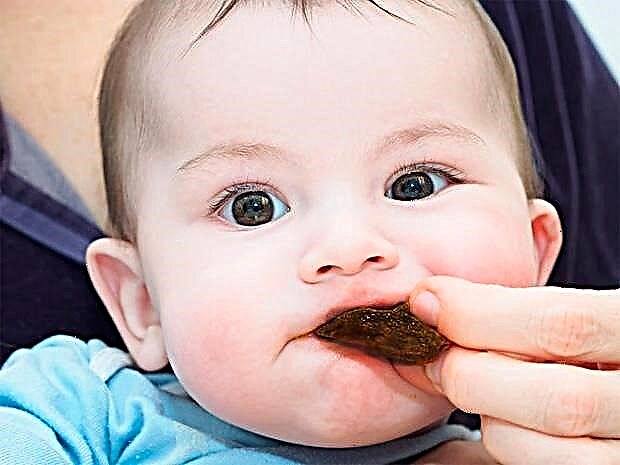
"Adrenalin" refers to medicines that save lives in certain situations. It is used in the treatment of anaphylactic shock, bronchospasm, arterial hypotension, cardiac arrest and other conditions. In childhood, it can also be prescribed as inhalation or nasal drops. Let's take a look at when “Adrenaline” recommends instructions for use, what is its dosage for laryngitis, what are the features of furacilin drops with adrenaline and other nuances of using this medication in children.

Features of the drug
The only dosage form of "Adrenaline" is an injection solution. It is sold in ampoules containing 5 ml of colorless (sometimes slightly colored) transparent liquid. The active ingredient of the drug is adrenaline hydrochloride or adrenaline bitartrate. Its second name is epinephrine.
The active compound of the solution is able to stimulate the alpha and beta adrenergic receptors, as a result of which many metabolic reactions are triggered in the body. The drug has a pronounced effect on the heart, increasing its contractions, as well as on the blood vessels.
In addition, it causes relaxation of the smooth muscles of the bronchi, inhibits intestinal motility, lowers intraocular pressure and dilates the pupils.

When is it used?
Traditionally, "Adrenaline" is prescribed for life-threatening conditions. The most common reason for using injections with such a drug is anaphylactic shock and other allergic reactionsthat develop in an immediate manner. Adrenaline shots are also used for resuscitation with asystole, with a severe attack of bronchial asthma and many other pathologies.
The dose of the drug in each of the cases when injections are needed is determined individually... Injections can even be prescribed to newborns, and the calculation is carried out by body weight. Local use of the solution is in demand for bleeding. With this treatment, the agent is applied to turundas and tampons.

Another common indication for the use of "Adrenaline" in children is acute inflammation of the larynx. This problem often occurs due to hypothermia and virus attacks. Laryngitis develops suddenly, manifesting itself as a sore throat, dryness, pain when talking, a hoarse and rough voice, dry paroxysmal cough.
Its dangerous complications are laryngeal edema and laryngospasm. It is at a high risk of such conditions that the doctor can prescribe Adrenaline to babies with laryngitis. In this case, the medicine will enter the child's body with the help of inhalation, acting directly on the inflamed area. In addition, in a similar way, the medication can be used for bronchospasm, allergic laryngitis and bronchiolitis.

How to carry out inhalation?
This method of application of "Adrenaline" involves the use of a nebulizer and a mask that is matched to the size. After the procedure, the swelling of the larynx and nasopharynx decreases, the blood flow is activated, and spasms are relieved. As a result of the manipulation, the mucous membrane is also moistened and the sputum is diluted. In addition, such inhalations promote the healing of microcracks, have some antiviral and antibacterial effects. They help prevent the spread of infection by preventing laryngitis from progressing to tracheitis or bronchitis.

The dosage of "Adrenaline" for one inhalation should be checked with the doctor. Most often, for babies 1-5 years old, they take from 0.25 to 0.5 ml of a treatment solution, for children over 5 years old - from 0.5 to 1 ml of the drug. The medication must be diluted with saline to get 3-4 ml of liquid, which is then poured into the nebulizer chamber. To assess the tolerance and response of the child's body, first, one inhalation is carried out under the supervision of a specialist, after which the doctor determines whether it is necessary to continue treatment.

It is impossible to use "Adrenaline" for inhalation therapy without a doctor's prescription, because there are many contraindications for it... The procedure is prohibited for children under 1 year old, as well as for fever, diseases of the cardiovascular system, increased fragility of blood vessels, individual intolerance and many other conditions. It is especially important to consult before treatment if the child is between 1 and 5 years old. Parents should clarify all the nuances, the list of which is quite large:
- preparation of the nebulizer for work is carried out in accordance with its instruction manual (it contains visual pictures);
- inhalation should be carried out in a calm state;
- after the procedure, there should be no physical exertion or other activity for at least 30 minutes;
- dilution of the drug is carried out immediately before use;
- you should breathe medicine no earlier than an hour after eating;
- the duration of the procedure should not exceed 10 minutes.

Drops
Another option for the use of "Adrenaline", especially in demand with a cold and adenoiditis, are complex drops... Several drugs are included in their composition, due to which the problem is influenced in a complex and quick manner. For example, in the case of lingering or chronic rhinitis, the doctor may prescribe the child "Furacilin drops" with the addition of adrenaline. The tool is a yellowish liquid, for the preparation of which both drugs are taken and combined in the volume prescribed by the doctor.

Treatment of the nasal passages with a solution that contains "Furacilin" and "Adrenaline", solves several problems at the same time - eliminates congestion, inhibits pathogenic bacteria, clears the mucous membrane. According to reviews, such complex drops are quite effective, but only a doctor should prescribe them to a child.
They can also include antihistamines, analgesics, antibiotics, essential oils, and other ingredients.

Such multicomponent solutions belong to individual remedies, that is, they will benefit one child, and only harm the other. Their use for a cold must necessarily be agreed with a specialist who determines both the required proportions of the medicinal solution and the optimal treatment regimen.
It is also important to clear the nasal passages before instillation and monitor shelf life drops (it is usually very short). In addition, if the medication is prescribed for young children, it is necessary to control the storage location of the drug in order to exclude the risk of swallowing, which poses a great danger.




